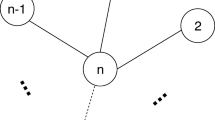Abstract
A weighted minimum colouring (WMC) game is induced by an undirected graph and a positive weight vector on its vertices. The value of a coalition in a WMC game is determined by the weighted chromatic number of its induced subgraph. A graph G is said to be globally (respectively, locally) WMC totally balanced, submodular, or PMAS-admissible, if for all positive integer weight vectors (respectively, for at least one positive integer weight vector), the corresponding WMC game is totally balanced, submodular or admits a population monotonic allocation scheme (PMAS). We show that a graph G is globally WMC totally balanced if and only if it is perfect, whereas any graph G is locally WMC totally balanced. Furthermore, G is globally (respectively, locally) WMC submodular if and only if it is complete multipartite (respectively, \((2K_2,P_4)\)-free). Finally, we show that G is globally PMAS-admissible if and only if it is \((2K_2,P_4)\)-free, and we provide a partial characterisation of locally PMAS-admissible graphs.





Similar content being viewed by others
Notes
Highway games are cooperative cost allocation games in which the cost to be allocated is associated with the construction of a highway network.
Quasi threshold graphs are also called comparability graphs Wölk (1965) or trivially perfect graphs.
References
Chu, F. (2008). A simple linear time certifying LBFS-based algorithm for recognizing trivially perfect graphs and their complements. Information Processing Letters, 107, 7–12. https://doi.org/10.1016/j.ipl.2007.12.009
Chudnovsky, M., Cornuéjols, G., Liu, X., Seymour, P., & Vuskovic, K. (2005). Recognizing berge graphs. Combinatorica, 25, 143–186. https://doi.org/10.1007/s00493-005-0012-8
Çiftçi, B., Borm, P., & Hamers, H. (2010). Highway games on weakly cyclic graphs. European Journal of Operational Research, 204(1), 117–124.
Corneil, D. G., Perl, Y., & Stewart, L. K. (1985). A linear recognition algorithm for cographs. SIAM Journal on Computing, 14(4), 926–934. https://doi.org/10.1137/0214065
Curiel, I. (1997). Cooperative game theory and applications: Cooperative games arising from combinatorial optimization problems. Kluwer Academic Publishers.
Deng, X., Ibaraki, T., & Nagamochi, H. (1999). Algorithmic aspects of the core of combinatorial optimization games. Mathematics of Operations Research, 24(3), 751–766.
Deng, X., Ibaraki, T., Nagamochi, H., & Zang, W. (2000). Totally balanced combinatorial optimization games. Mathematical Programming, 87, 441–452.
Gillies, D. B. (1959). Contributions to the Theory of Games. In A. Tucker & R. Luce (Eds.), Solutions to general non-zero-sum games (pp. 47–85). Princeton University Press.
Granot, D., & Hamers, H. (2004). On the equivalence between some local and global chinese postman and traveling salesman graphs. Discrete Applied Mathematics, 134(1–3), 67–76.
Granot, D., Hamers, H., & Tijs, S. (1999). On some balanced, totally balanced and submodular delivery games. Mathematical Programming, 86(2), 355–366.
Granot, D., Granot, F., & Zhu, W. R. (2000). Naturally submodular digraphs and forbidden digraph configurations. Discrete Applied Mathematics, 100(1–2), 67–84.
Hamers, H., Miquel, S., & Norde, H. (2014). Monotonic stable solutions for minimum coloring games. Mathematical Programming, 145, 509–529.
Herer, Y. T., & Penn, M. (1995). Characterizations of natural submodular graphs: A polynomially solvable class of the TSP. Proceedings of the American Mathematical Society, 123(3), 673–679.
Lovász, L. (1972). Normal hypergraphs and the perfect graph conjecture. Discrete Mathematics, 2(3), 253–267.
Maschler, M., Peleg, B., & Shapley, L. S. (1971). The kernel and bargaining set for convex games. International Journal of Game Theory, 1, 73–93.
McDiarmid, C., & Reed, B. (2000). Channel assignment and weighted coloring. Networks, 36(2), 114–117.
Okamoto, Y. (2003). Submodularity of some classes of the combinatorial optimization games. Mathematical Methods of Operations Research, 58(1), 131–139.
Schrijver, A. (2003). Combinatorial optimization. Springer.
Shapley, L. S. (1971). Cores of convex games. International Journal of Game Theory, 1(1), 11–26.
Sprumont, Y. (1990). Population monotonic allocation schemes for cooperative games with transferable utility. Games and Economic Behavior, 2(4), 378–394.
Wölk, E. S. (1965). A note on“the comparability graph of a tree”. Proceedings of the American Mathematical Society, 16, 17–20.
Yan, J., Chen, J., & Chang, G. J. (1996). Quasi-threshold graphs. Discrete Applied Mathematics, 69, 247–255.
Author information
Authors and Affiliations
Ethics declarations
Conflict of interest
The authors declare that they have no conflict of interest.
Additional information
Publisher's Note
Springer Nature remains neutral with regard to jurisdictional claims in published maps and institutional affiliations.
Trine Platz gratefully acknowledges financial support from the Independent Research Fund Denmark \(\mid \) Social Sciences (Grant ID: DFF-6109-000132)
Rights and permissions
About this article
Cite this article
Hamers, H., Horozoglu, N., Norde, H. et al. On the properties of weighted minimum colouring games. Ann Oper Res 318, 963–983 (2022). https://doi.org/10.1007/s10479-021-04374-9
Accepted:
Published:
Issue Date:
DOI: https://doi.org/10.1007/s10479-021-04374-9




